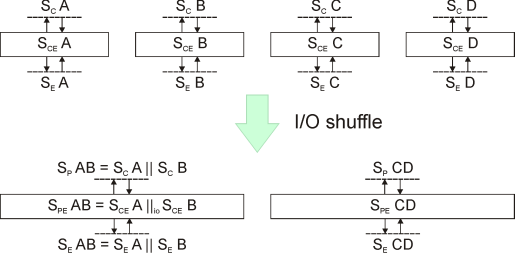| |
|
||||||
|
|
|||||||
|
HioSys PlugInThe I/O-Based Approach - Step by Step
Step 4: Subsystem CompositionWe suggest that groups of a comparatively small number of plant components shall be described by a compound model and equipped with control and measurement aggregation by one superposed I/O controller per group. At this point, the complexity of the compound model of each group (that is exponential in the number of components) is effectively reduced by the use of abstractions in the preceding step. We formally obtain a compound model of the group by a shuffle product composition and model the interaction of the plant components by an environment model, see Step 5. To technically capture the behaviour of two I/O plants S_PEi in one mathematical model, we use the I/O shuffle operation S_PE1||_ioS_PE2, see function HioShuffle. It is based on the ordinary shuffle product (parallel composition under absence of shared events), but restricted by the additional condition L_io on the ordering of input-output event-pairs and extended by a well-defined error behaviour L_err. The latter accounts for situations where L_io is violated, i.e. a measurement event from the one plant component is replied to by a control event to the other plant component. The behaviour of the individual components is not restricted by this composition, as interaction is modeled separately in the environment model, see Step 5. As the I/O shuffle formally results in an I/O plant, we still obtain a set of I/O plants by this step. The individual constraints of the plant components are simply merged to compound constraints S_P and S_E by Parallel composition. Formally, to sustain I/O-constraint structure, the results can be restricted to the above condition L_io on the ordering of input-output event-pairs. In practice (like in the lua and C++ tutorial), this restriction can be omitted having in mind that it is already included in the I/O shuffle itself. Transport Unit.(C++ lua) Using the function HioShuffle, we form groups of (the abstractions of) two TU's each, which results in compound plant models TU AB, TU CD, TU EF and TU GH. Note that up to now, the interaction between the individual components is not described by these models.
libFAUDES 2.33h --- 2025.09.16 --- with "synthesis-omegaaut-observer-diagnosis-iosystem-hiosys-multitasking-coordinationcontrol-timed-iodevice-priorities-simulator-luabindings" |
